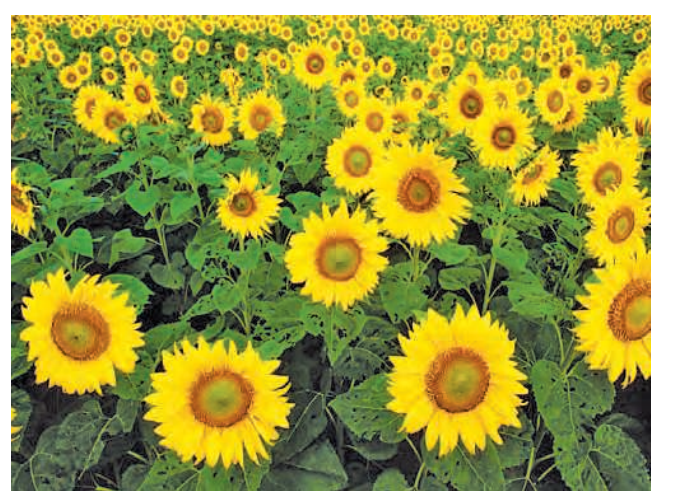KSEEB Class 10 SSLC Biology Chapter 2 Control and Coordination Notes
All the living organisms (plants and animals) respond and react to changes in the environment around them. The changes in the environment to which the organisms respond and react are called stimuli (singular of stimuli is stimulus). The living organisms show response to stimuli such as light, heat, cold, sound, smell, taste, touch, pressure, pain, water, and force of gravity, etc.
The response of organisms to a stimulus is usually in the form of some movement of their body part. For example, if a man touches a very hot utensil accidently, he quickly pulls his hand away from the hot utensil. Here, heat is the stimulus and the man reacts by moving his hand away from the hot utensil. Similarly, when the sun is bright, we close our eyes. In this case, light is the stimulus and we react by closing the eyes.

We know that a sunflower always faces the sun. Here, sunlight is the stimulus and sunflower reacts by bending (or moving) towards the sun. We eat food when we are hungry (and need energy). In this case, hunger is the stimulus and we react by eating food. From the above discussion we conclude that the reaction to stimuli is a characteristic property of the living organisms. Another word which is also used in place of ‘reaction’ is ‘response’. So, we can also say that the response to stimuli is a characteristic property of the living organisms.
“KSEEB Class 10 Biology Control and Coordination notes”
Both, plants and animals react (or respond) to various stimuli around them. But the method of reacting to stimuli is not similar in plants and animals. They react to stimuli in different ways. For example, plants bend towards light but animals do not bend towards light. The animal Amoeba reacts to the presence of food by moving towards the food particle. Similarly, Amoebae tend to aggregate (collect together) in moderately warm water which is their reaction to the stimulus called heat. Amoeba and other protozoa react to the mechanical obstacles by avoiding them.
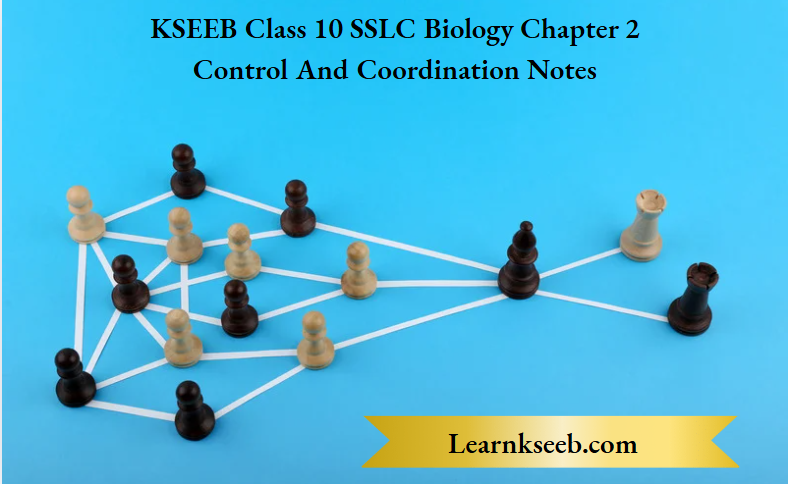
We find that the Amoeba (which is an animal) can react to different stimuli in different ways. The animals can react to stimuli in many different ways because they have a nervous system and an endocrine system involving hormones. The plants, however, react to stimuli in a very limited way. This is because the plants do not have a nervous system like the animals have. The plants use only the hormones for producing reaction to external stimuli.
From all the above examples we conclude that when a stimulus acts on our body, then we react (or respond) in a manner which is in the best interest of our body. The reaction (or response) which we give to the stimulus involves many organs of our body. It is, therefore, necessary that all the concerned organs should work with one another in a systematic manner so as to produce the required reaction. In other words, the various organs should co-operate with one another to provide proper reaction to the stimulus.
The working together of the various organs of an organism in a systematic manner so as to produce a proper response to the stimulus, is called coordination. We will now discuss the control and coordination in plants, animals and human beings, one by one. Let us start with control and coordination in plants.
KSEEB Class 10 SSLC Biology Chapter 2 Control and Coordination In Plants
The plants do not have a nervous system and sense organs like eyes, ears, or nose, etc., like the animals, but they can still sense things. The plants can sense the presence of stimuli like light, gravity, chemica water, and uch, etc., and respond to them. The plants can sense things like light, gravity, chemicals, water, and touch, etc., by the action of hormones in them. The stimuli like light, gravity, chemicals, water, and touch, etc., are called environmental changes.
So, we can also say that the plants coordinate their behaviour against environmental changes by using hormones. The hormones in plants do not act the same way as in animals. The hormones in plants coordinate their behaviour by affecting the growth of a plant. And the effect on growth of the plant can result in the movement of a part of the plant like shoot (stem) or root, etc. Animals use both nervous system and hormones for coordination of their activities.
Plants have no nervous system, so plants use only hormones for coordination. Thus, the reaction (or response) of plants to different stimuli like light, gravity, chemical substances, water, and touch etc., is due to the effect of hormones. Please note that animals can respond quickly because they have a nervous system. Plants cannot respond quickly because they have no nervous system. The plants respond to various stimuli very slowly by growing. So, in most of the cases, the response of a plant to a stimulus cannot be observed immediately. It usually takes a considerable time to observe the effect of a stimulus on a plant
From the above discussion we conclude that the function of control and coordination in plants is performed by the chemical substances called plant hormones. Please note that the plant hormones are also called phytohormones (‘phyto’ means ‘plant’). Before we discuss the various types of plant hormones, we should know the meanings of ‘dormancy’ and ‘breaking of dormancy’. A resting, inactive condition in which metabolism almost stops is called dormancy.
The seed of a plant is inactive or dormant. It has dormancy. A seed must have certain conditions like water, warmth, air and hormones to break dormancy and germinate to form a seedling (which then grows into a plant). Another part of a plant having dormancy is the bud. The bud is a young, undeveloped shoot of a plant which on breaking dormancy can form a branch, a leaf or a flower depending on its position in the plant. The breaking of dormancy of a bud also requires certain plant hormones. Keeping these points in mind, we will now discuss the various types of plant hormones.
KSEEB Class 10 SSLC Biology Chapter 2 Control and Coordination Plant Hormones
The control and coordination in plants is done by plant hormones (or phytohormones). The plant hormones coordinate the activities of the plant by controlling one or the other aspect of the growth of the plant. So, the plant hormones are also known as plant growth substances. The growth of a plant can be divided into three stages : cell division, cell enlargement and cell differentiation (or cell specialisation), and these stages have particular locations in a plant. These three stages of plant growth as well as promotion of dormancy, breaking of dormancy, stomata control, falling of leaves, fruit growth, ripening of fruits and ageing in plants are controlled by the various plant hormones.
There are four major types of plant hormones (or phytohormones) which are involved in the control and coordination in plants. These are :
- Auxins,
- . Gibberellins,
- Cytokinins, and
- Abscisic acid (ABA).
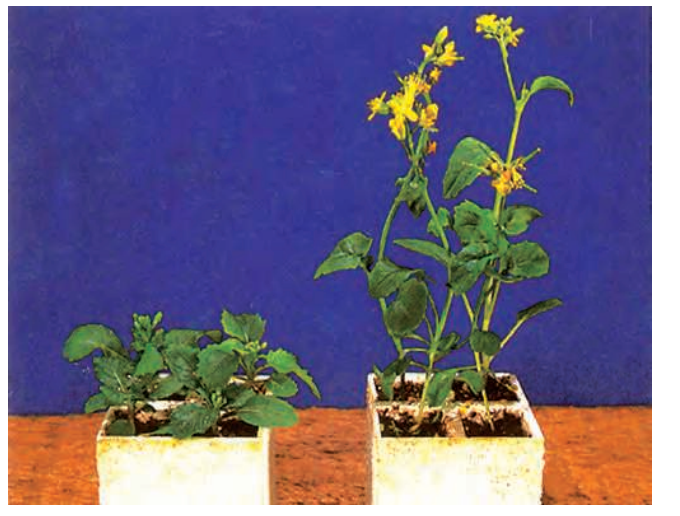
Auxins, gibberellins and cytokinins are the plant hormones which promote growth of plants. On the other hand, abscisic acid is a plant hormone which inhibits (or prevents) the growth. The detailed functions of the various plant hormones are given below.
- Auxins are the plant hormones which promote cell enlargement and cell differentiation in plants. Auxins also promote fruit growth. Auxin hormone controls a plant’s response to light and gravity. In other words, auxin hormone is responsible for the phototropic and geotropic responses of plants. Auxin is made by cells at the tip of stems and roots. Auxin moves away from light, and towards gravity. Auxin has opposite effect on the growth of stem and roots. Auxin speeds up growth in stem but it slows down growth in roots. Synthetic auxins are applied in agriculture and horticulture.
- Gibberellins are plant hormones which promote cell enlargement and cell differentiation in the presence of auxins. Gibberellins help in breaking the dormancy in seeds and buds. They also promote growth in fruits. Gibberellin hormone is involved mainly in shoot extensions. Gibberellin stimulates elongation of shoots of various plants.
- Cytokinins are the plant hormones which promote cell division in plants. Cytokinins also help in breaking the dormancy of seeds and buds. They delay the ageing in leaves. Cytokinins promote the opening of stomata. They also promote fruit growth.
- Abscisic acid is a plant hormone which functions mainly as a growth inhibitor. Abscisic acid promotes the dormancy in seeds and buds (this is the opposite of breaking of dormancy). It also promotes the closing of stomata. Abscisic acid promotes the wilting and falling of leaves (which is called abscission). It also causes the detachment of flowers and fruits from the plants.
KSEEB Class 10 SSLC Biology Chapter 2 Control and Coordination Plant Movements
The plants are fixed at a place with their roots in the ground, so they cannot move from one place to another. That is, plants do not show locomotion (movement of the entire body). However, movements of the individual parts or organs of a plant (like shoot, root, leaves, etc.) are possible when they are subjected to some external stimuli like light, force of gravity, chemical substances, water, and touch, etc.
These movements of the plant part are usually caused by an unequal growth in its two regions by the action of plant hormones, under the influence of the stimulus.
“SSLC Biology Chapter 2 Control and Coordination explained”
For example, the auxin hormone is made and secreted by the meristematic tissue at the tip of stem (or tip of shoot). The auxin hormone speeds up the growth in stems. So, if one side of a stem has more auxin than the other side, then the side of stem having more auxin hormone will grow faster than the other side (having less auxin hormone). This will cause the stem to bend. And when the stem bends to one side, we say that the stem is showing movement.
This movement (or bending) of the stem has been caused by its growth. So, we can say that the bending of a stem (or shoot) (when exposed to light from one side) is a growth movement. In fact, the movement in any part of a plant is usually a growth movement. Please
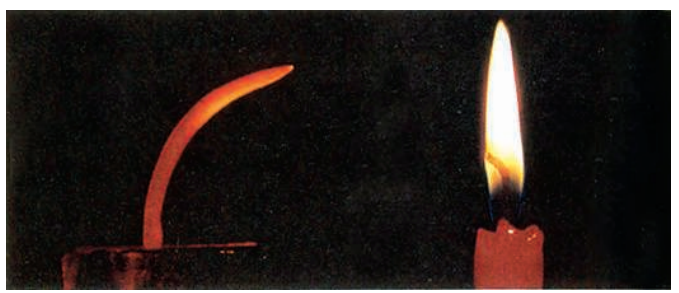 note that when a plant part shows movement, it remains attached to the main body of the plant. It does not get detached from it. We will now discuss tropism in which the part of a plant shows movement in response to various stimuli. The plant movements made in response to external stimuli fall into two main categories : tropisms and nasties.
note that when a plant part shows movement, it remains attached to the main body of the plant. It does not get detached from it. We will now discuss tropism in which the part of a plant shows movement in response to various stimuli. The plant movements made in response to external stimuli fall into two main categories : tropisms and nasties.
Though all the tropisms are growth movements but nasties may be growth movements or growth- independent movements. In tropisms, the direction of stimulus determines the direction of movement of the plant part but in nasties the direction of movement is not determined by the direction of stimulus.
KSEEB Class 10 SSLC Biology Chapter 2 Control and Coordination Tropisms
A growth movement of a plant part in response to an external stimulus in which the direction of stimulus determines the direction of response is called tropism. Thus, tropism is a directional movement of the part of a plant caused by its growth. The growth of a plant part in response to a stimulus can be towards the stimulus (in the direction of stimulus) or away from the stimulus (against the direction of stimulus) due to which we can have a positive tropism or negative tropism, respectively. So :
- . If the growth (or movement) of a plant part is towards the stimulus, it is called positive tropism, and
- If the growth (or movement) of a plant part is away from the stimulus, then it is called negative tropism.
We will now give an example of tropism. When a growing plant is exposed to light from only one side, then it responds by bending its stem (or shoot) towards the light. This is an example of phototropism (which is caused by the ‘light’ acting as ‘stimulus’. ‘Photo’ stands for ‘light’). The bending of the plant stem (or shoot) towards light is actually positive phototropism.
Types of Tropisms
There are five common stimuli in the environment : light, gravity, chemicals, water and touch (or contact). These five stimuli give us five types of tropisms : phototropism, geotropism, chemotropism, hydrotropism and thigmotropism. In phototropism, the stimulus is light; in geotropism the stimulus is gravity, in chemotropism the stimulus is a chemical, in hydrotropism the stimulus is water, and in thigmotropism the stimulus is touch (of a solid surface). It is obvious that the tropisms are named according to the stimulus.
This will become clear from the following table.
We will now give the definitions of all the five types of tropisms.
- The movement of a plant part in response to light is called phototropism. In other words, the response of a plant to light is called phototropism. If the plant part moves towards light, it is called positivephototropism. On the other hand, if the plant part moves away from light, then it is called negativephototropism. The stem (or shoot) of a growing plant bends towards light, so the stem (or shoot) of a plant shows positive phototropism. On the other hand, the roots of a plant move away from light, so the roots of a plant show negative phototropism.
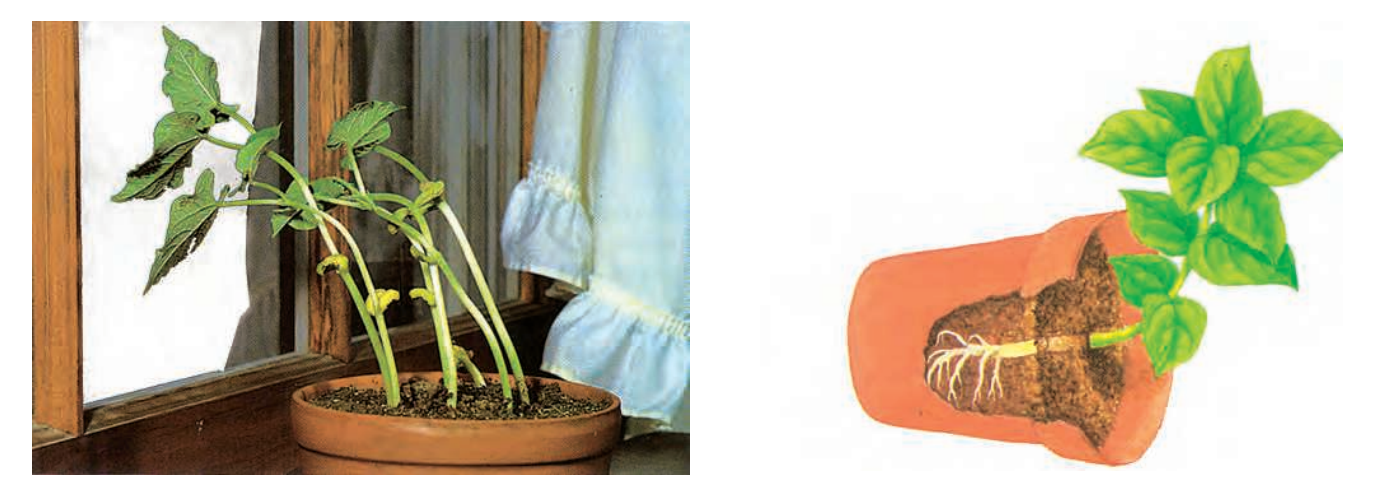
- The movement of a plant part in response to gravity is called geotropism. In other words, the response of a plant to gravity is called geotropism. If the plant part moves in the direction of gravity, it is called positive geotropism. On the other hand, if the plant part moves against the direction of gravity, it is negative geotropism (Please note that the force of gravity acts in the downward direction). Now, the roots of a plant move downwards in the direction of gravity, so the roots of a plant show positive geotropism. On the other hand, the stem (or shoot) of a plant moves upwards against the direction of gravity, so the stem (or shoot) of a plant shows negative geotropism
- The movement of a plant part in response to a chemical stimulus is called chemotropism. In other words, the response of a plant to chemical stimulus is called chemotropism. If the plant part shows movement (or growth) towards the chemical, it is called positive chemotropism. On the other hand, if the plant part shows movement (or growth) away from the chemical, then it is called negative chemotropism. The growth of pollen tube towards the ovule during the process of fertilisation in a flower is an example of chemotropism (It is actually positive chemotropism). In this case the pollen tube grows towards the sugary substance (chemical) secreted by the ripe stigma of carpel in the flower.
- The movement of a plant part in response to water is called hydrotropism. In other words, the response of a plant part to water is called hydrotropism. If the plant part moves towards water, it is called positive hydrotropism. On the other hand, if the plant part moves away from water, then it is called negative hydrotropism. The roots of a plant always go towards water, so roots are positively hydrotropic
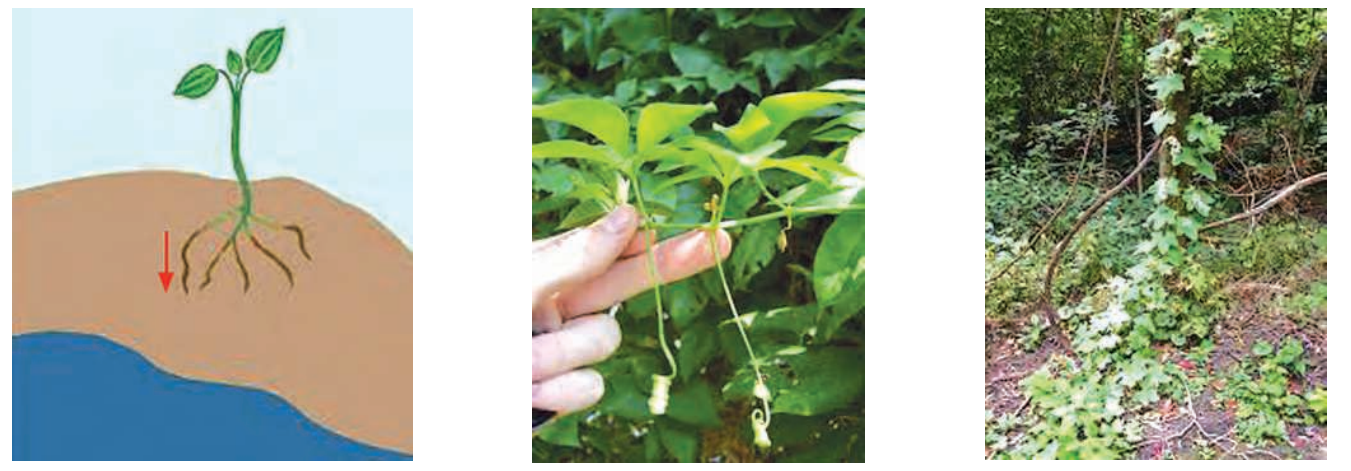
The directional growth movement of a plant part in response to the touch of an object is called thigmotropism. The climbing parts of the plants such as tendrils grow towards any support which they happen to touch and wind around that support. So, tendrils of plants are positively thigmotropic. We will now describe a plant’s response to light, gravity, chemicals, water and touch with the help of diagrams.
KSEEB Class 10 SSLC Biology Chapter 2 Control and Coordination Response of Plants To Light: Phototropism
Plants need sunlight, so the stems (or shoots) respond to sunlight by growing towards it. The plants also turn their leaves to face the sun. This makes sure that the leaves get as much sunlight as possible. When a plant is grown in the open ground with the sunlight coming from above, then the stem of plant grows straight up.
If, however, the plant is grown with sunlight coming from one side, then the stem of plant bends towards the direction from which the sunlight comes. The root of plant, however, bends away from the direction from which the sunlight comes. We will now describe an experiment to show the response of plant parts to light.
“KSEEB SSLC Control and Coordination chapter summary”
We take a potted plant growing in a transparent glass jar. When this potted plant is kept in the open space, the sunlight falls from above due to which the stem of plant grows straight up towards the source of light ´sun’. The root of plant also grows straight but in the downward direction.
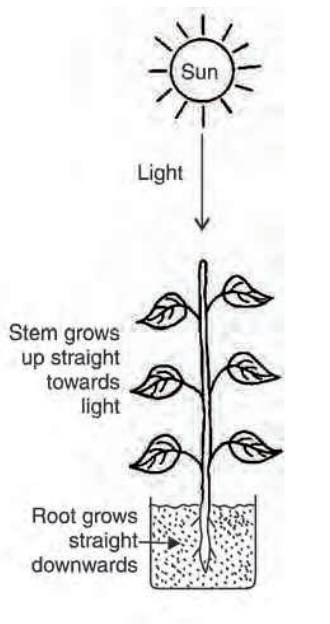
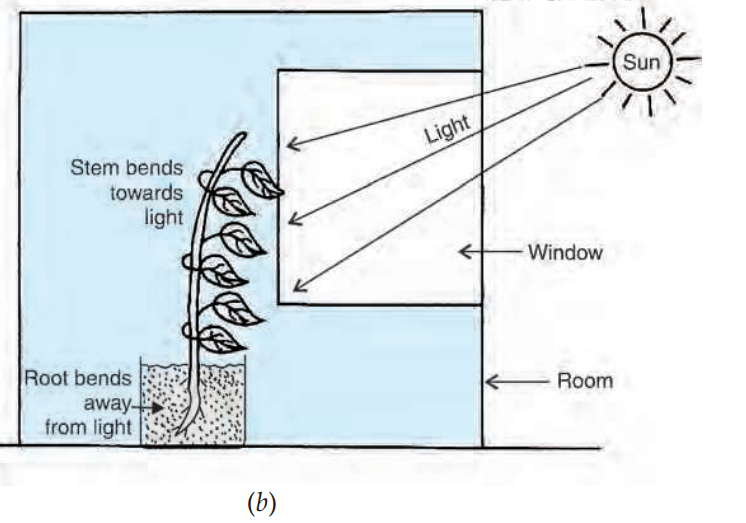
Let us now keep the potted plant having straight stem and straight root near the window in a dark room so that sunlight falls on it from the right side (through the window) only. After some days we will see that the stem of the plant bends towards the right side from where the light is coming. This observation shows that the stem of plant responds to light and bends towards it. Even the leaves of the plant turn towards the sun so as to obtain the maximum sunlight. Thus, the stem (and leaves) of a plant are positively phototropic.
Now, if we look at the root of the plant in Figure 10(b), we find that the root bends to the left side away from the light. This observation shows that the root of plant responds to light by growing away from it. Thus, the root of plant is negatively phototropic. We will now explain the bending of a plant stem towards sunlight. The plant stem responds to light and bends towards it due to the action of ‘auxin hormone’. This happens as follows:
- When sunlight comes from above, then the auxin hormone present in the tip of the stem spreads uniformly down the stem. Due to the equal presence of auxin, both the sides of the stem (A and B) grow equally rapidly. And the stem grows straight up.

- When the light falls only on the right side of the stem [side B in Figure 11(b)], then the auxin hormone collects in the left side (shady side A) of the stem, away from light. This is because auxin hormone prefers to stay in shade.
- Now, more auxin hormone is present in the left side of stem but not on its right side. Due to more auxin hormone, the left side (A) of stem grows faster than its right side (B) where there is no auxin. Since the left side of stem grows faster and becomes longer than its right side, therefore, the stem bends towards the right side (in the direction of light). We can also explain the bending of a plant root away from light by the action of auxin hormone
- . For this we have to remember that the effect of auxin on the growth of a root is exactly opposite to that on a stem. Thus, though auxin hormone increases the rate of growth in a stem but it decreases the rate of growth in a root. Now, the side of a root away from light will have all the auxin concentrated in it. Due to this, the side of root which is away from light will grow slower than the other side and make the root bend away from light. Please draw the diagram to show the bending of plant root away from light yourself.
KSEEB Class 10 SSLC Biology Chapter 2 Control and Coordination The Response of Plants to Gravity : Geotropism
The force with which the earth pulls all the things towards it, is called gravity. The force of gravity always acts in the downward direction. The response of plants to gravity is called geotropism. Geotropism is also known as gravitropism.
- The roots of plants always grow downward in response to gravity. This makes sure that they will find soil and water.
- The stems (or shoots) of plants always grow up, away from the pull of gravity. This makes sure that they will get light.
The movement of plant roots towards the earth and that of stem away from earth, both are cases of geotropism. Since the roots grow down towards the pull of gravity, so the downward growth (or downward movement) of roots is called positive geotropism. The stem (or shoot) grows upwards, away from the pull of gravity, so the upward growth (or upward movement) of stem or shoot is called negative geotropism. The response of plants to gravity (or geotropism) will become more clear from the following experiment. - We take a potted plant growing in a transparent glass jar. When this potted plant is kept in the normal position, we can see that its roots are growing downwards and its stem is growing upwards
 Let us now tilt the potted plant and keep the pot horizontally on its side as shown. In this position, the roots and stem both are parallel to the ground (or earth). Allow the plant to remain in this position for a few days.
Let us now tilt the potted plant and keep the pot horizontally on its side as shown. In this position, the roots and stem both are parallel to the ground (or earth). Allow the plant to remain in this position for a few days.- After a few days we will find that the roots of the potted plant bend downwards towards the earth and the stem of plant bends upwards, away from the earth. The roots of plant grow downwards in response to the pull of gravity. The stem of plant responds to gravity in the opposite way, by growing upwards (away from the pull of gravity). Response of Plants to Chemicals : Chemotropism The growth (or movement) of a plant part due to chemical stimulus is known as chemotropism.
The growth (or movement) of a pollen tube towards the ovule induced by a sugary substance as stimulus, is an example of chemotropism. This can be explained as follows: The ripe stigma in the carpel of a flower secretes a chemical substance (which is a sugary substance) into the style towards the ovary.

This sugary substance acts as a stimulus for the pollen grains which fall on the stigma of the carpel. The pollen grain responds to this stimulus by growing a pollen tube in the downward direction into the style of the carpel and reaches the ovule in the ovary of the flower for carrying out fertilisation. This growth of the pollen tube in response to a chemical substance secreted by the stigma of a flower is an example of chemotropism.
Response of Plants to Water : Hydrotropism
The roots of plants always go towards water, even if it means going against the pull of gravity. Though roots normally grow downwards but in order to reach water, they can grow sideways or even upwards! The roots grow in the direction of source of water so as to obtain water for the developing plant.
Since roots always grow (or move) towards water, therefore, roots are positively hydrotropic. When the roots bend by growing towards water, it appears that they move towards water. We will now describe an experiment to demonstrate hydrotropism. This will show us the response of roots to water. We take two glass troughs A and B and fill each one of them two-thirds with soil (see Figure 14). In trough A we plant a tiny seedling.
In trough B we plant a similar seedling and also place a small ‘clay pot’ inside the soil . Water the soil in trough A daily and uniformly. Do not water the soil in trough B but put some water in the clay pot buried in the soil. Leave both the troughs for a few days.

Now, dig up the seedlings carefully from both the troughs without damaging their roots. We will find that the root of seedling in trough A is straight. On the other hand, the root of seedling in trough B is found to be bent to the right side (towards the clay pot containing water). This can be explained as follows. In trough A, the root of seedling gets water from both sides (because the soil is watered uniformly).
But in trough B, the root gets water oozing out from the clay pot which is kept on the right side. So, the root of seedling in trough B grows and bends towards the source of water to the right side. This experiment shows that the root of a plant grows towards water. In other words, the root of a plant is positively hydrotropic.
Directional Response of Plants to the Touch of an Object: Thigmotropism
There are some plants called ‘climbing plants’ which have weak stems and hence cannot stand upright (or erect) on their own. The climbing plants have climbing organs called tendrils. Tendrils are the thin, thread-like growths on the stems or leaves of climbing plants. Thus, there are two types of tendrils : stem tendrils and leaf tendrils. Tendrils are sensitive to the touch (or contact) of other objects.
That is, tendrils have cells which can sense their contact with a nearby solid object like a bamboo stick, or the stem of another plant. So, when a tendril touches an object, then the side of tendril in contact with the object grows slowly than its other side. This causes the tendril to bend towards the object by growing towards it, wind around the object and cling to it. The winding movement of the tendril of a climbing plant is an example of thigmotropism. The stimulus in thigmotropism is the touch (or contact) of an object. The winding movement of the tendril of a plant around a nearby object gives support to the plant having a weak stem.
Thigmotropism is often seen in plants having tendrils. Tendrils are positively thigmotropic which means that they grow towards things they happen to touch. The plants having stem tendrils or leaf tendrils which are positively thigmotropic climb up artificial supports, other plants or fences very easily. The plants such as bitter gourd (karela), bottle gourd (lauki), grape vine and passion flower have stem tendrils which are positively thigmotropic and make these plants to climb up by winding around various types of supports. The plants such as peas and glory lily have leaf tendrils which are positively thigmotropic.
These leaf tendrils also make their plants to climb up by winding around various types of nearby supports. From the above discussion we conclude that tendrils are the climbing organs of the plants which are positively thigmotropic.
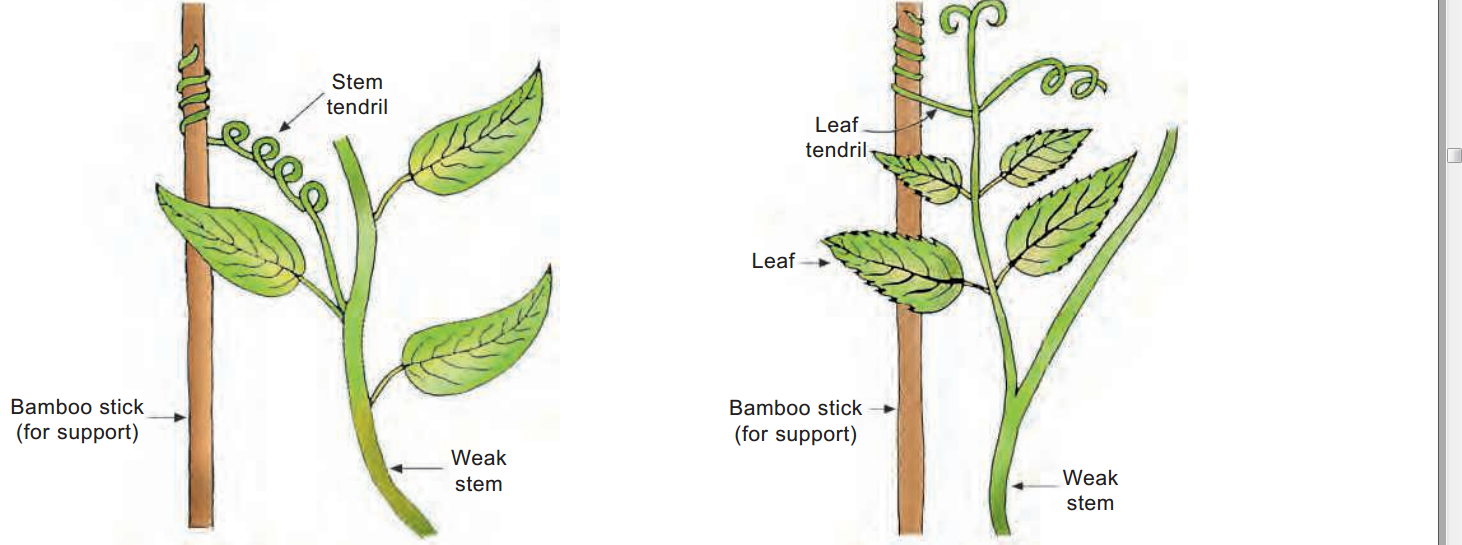
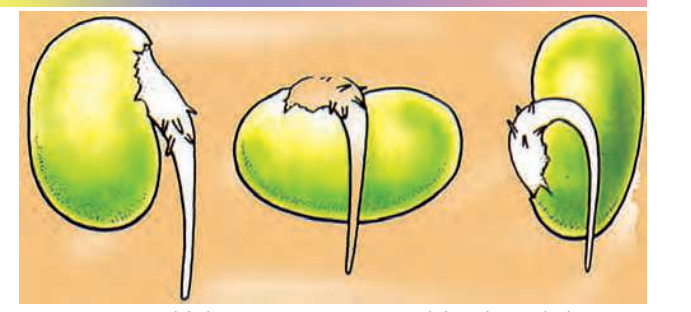
The Usefulness of Tropic Movements
The various types of tropic movements help the plants to survive. For example, even if a seed is planted upside down, its root will still grow downwards into earth because it is positively geotropic (see Figure 16). The root will also grow towards water because it is positively hydrotropic. Similarly, the shoot of such a seed will grow upwards because it is negatively geotropic and towards light because it is positively phototropic. These tropic movements help the plants to obtain water and nutrients from soil and light from the sun, which are necessary for their growth and survival.
KSEEB Class 10 SSLC Biology Chapter 2 Control and Coordination Nasties
We have just studied that in tropism, a plant part either moves towards the stimulus or away from the stimulus. However, in some plants, the movement of the plant part is neither towards the stimulus nor away from the stimulus. That is, the movement of plant part in some plants is not in a particular direction with respect to stimulus. The movement of a plant part in response to an external stimulus in which the direction of response is not determined by the direction of stimulus is called nastic movement. Nastic movements of plants are also called nasties. The nastic movements of plants are induced by stimuli such as heat, light, touch (or contact), etc.
“Class 10 Karnataka Board Biology Chapter 2 notes”
The main difference between tropic and nastic movements is that tropic movement is a directional movement of a plant part but nastic movement is not a directional movement of the plant part with respect to the stimulus. The direction of nastic movement is not determined by the direction from which the stimulus is applied. In nastic movement, from whichever direction the stimulus is applied, it affects all the parts of the organ of a plant equally and they always move in the same direction. Nastic movements are mostly exhibited by the flat organs of the plants like ‘leaves’ and ‘petals of flowers’. Some of the examples of the nastic movements of plants (or nasties) are given below :
- The folding up of the leaves of a sensitive plant (Mimosa pudica) on touching is an example of nastic movement. Here the stimulus is touch.
- The opening up of the petals of dandelion flowers in morning in bright light and closing in the evening when the light fades is an example of nastic movement. In this case the stimulus is light.
- The closing of the petals of moonflower in the morning in bright light and opening at dark when the light fades is also an example of nastic movement. In this case also the stimulus is light. Please note that though all tropisms are growth movements but all nasties (or nastic movements) are not growth movements. Nastic movements may or may not be growth movements.
- For example, the folding up of the leaves of a sensitive plant on touching is not a growth movement but the opening and closing of petals of flowers by the action of sunlight is a growth movement. We have just said that most of the movements of the plant parts are caused by their growth. Now, since the growth of a plant part is usually a slow process, therefore, most of the movements of plant parts are very slow. There are, however, some exceptions.
- We will now describe the movement of a plant part (leaves) which is unusually fast and takes place almost immediately. It is the folding up of the leaves of a sensitive plant when touched with a finger (or any other object). This is discussed below under the topic on thigmonasty.
KSEEB Class 10 SSLC Biology Chapter 2 Control and Coordination Thigmonasty
The non-directional movement of a plant part in response to the touch of an object is called thigmonasty. In other words, thigmonasty is the nastic movement of a plant part in response to touch. Thus, the stimulus in thigmonasty is the ‘touch’. An example of the nastic movement in plants caused by touch (or thigmonasty) is provided by the sensitive plant (Mimosa pudica) which is also known as touch- me-not plant. It is called chhui-mui in Hindi.
If we touch the leaves (or rather leaflets) of the sensitive plant with our fingers, then its leaves fold up and droop almost immediately. The folding up of the leaves of sensitive plant on touching, is an example of nastic movements in plants (in which the stimulus is the ‘touch’ of our fingers

In this case, the ‘touch’ of our fingers is the stimulus and the leaves respond by ‘folding up’. Please note that the folding of leaves of a sensitive plant is not a case of tropism (like thigmotropism) because in this case the direction of movement of leaves does not depend on the direction of stimulus (touch). We will now describe how the leaves of a sensitive plant fold up when touched.
The sensitive plant has pad-like swellings called ‘pulvini’ at the base of each leaf. (The singular of pulvini is pulvinus). The pulvini contain a lot of water in their cells. Due to the internal ‘water pressure’ in them (called turgor), all the pulvini are very firm and hold the leaves above them upright
The pulvini have also large intercellular spaces (empty spaces) between their cells. The folding up of the leaves of a sensitive plant on touching is due to the sudden loss of water from pad-like swellings called ‘pulvini’ present at the base of all leaves of the sensitive plant which make the pulvini lose their firmness causing the leaves to droop and fall.
“Detailed notes on Control and Coordination for Class 10 SSLC”
This happens as follows. When the leaves of sensitive plant (having pulvini at their base) are touched with a finger, then an electrical impulse is generated which travels through ordinary cells (because there are no nerve cells insensitive plant or other plants).
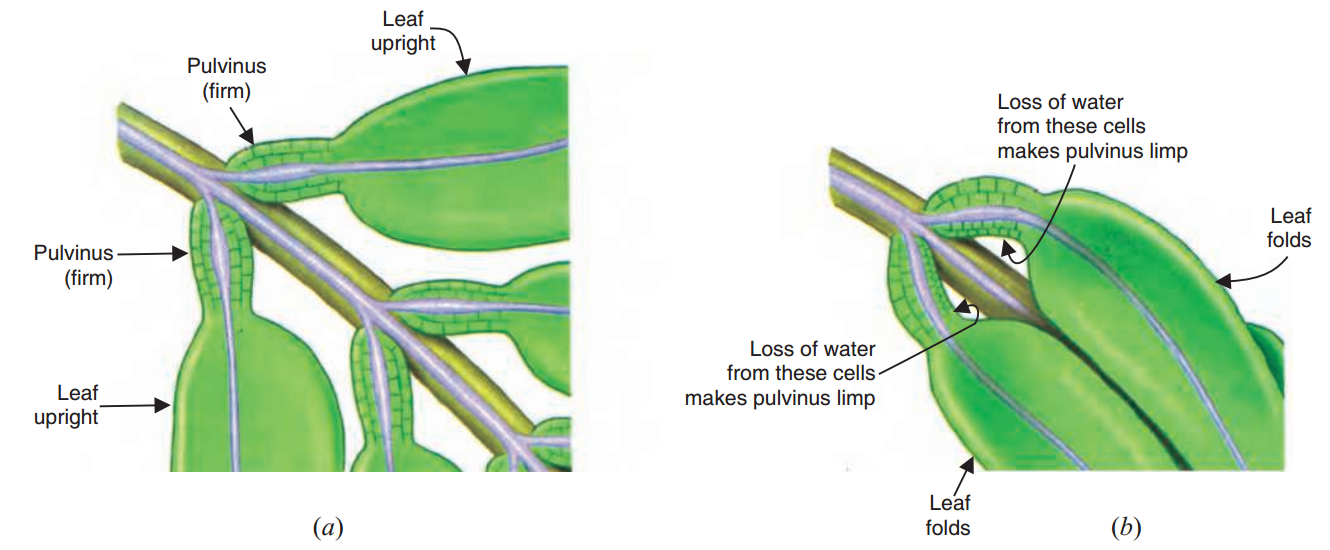
This electrical impulse acts on a plant hormone. The plant hormone makes the water migrate from the cells of one half of a pulvinus to the intercellular spaces in the other half of pulvinus. This loss of water from half of pulvinus causes the pulvinus to lose its firmness making the leaf to fold [see Figure 18(b)]. Similarly, all the pulvini lose firmness and become limp due to which all the leaves above them collapse and fold up. At a gap of 15 to 30 minutes after the leaves have folded, water usually diffuses back into same cells of pulvinus from which it left, and the leaf returns to its original position
KSEEB Class 10 SSLC Biology Chapter 2 Control and Coordination Photonasty

The non-directional movement of a plant part (usually petals of flowers) in response to light is called photonasty. In other words, photonasty is the nastic movement of a plant part (like petals of flowers) in response to light. Thus, the stimulus in photonasty is light.
A dandelion flower opens up in the morning in bright light but closes in the evening when the light fades and it gets dark. The opening and closing of petals of dandelion flowers in response to the intensity of light is an example of nastic movement in which the stimulus is light. In other words, it is an example of photonasty. The moonflower behaves exactly opposite to that of dandelion flowers in respect of response to light.
“KSEEB SSLC Chapter 2 Control and Coordination important topics”
The petals of moonflower close during the day when there is bright light but open up at night when it is dark and there is no light (see Figure 20). This is also an example of photonasty. Please note that the opening and closing of flowers in response to light (or photonasty) are growth movements. Petals open when their inner surfaces grow more than their outer surfaces. On the other hand, petals close when their outer surfaces grow more than their inner surfaces.
Before we end this discussion, we would like to give the functions of plant hormones. Functions of Plant Hormones (or Phytohormones) The plant hormones (or phytohormones) regulate many functions in plants. The various functions in plants which are regulated by the plant hormones (or phytohormones) are :
- Germination of seeds (or Breaking the dormancy of seeds),
- Growth of root, stem and leaves,
- Movement of stomata (or stomatal movement) in leaves,
- Flowering of plants,
- Ripening of fruits, and
- Phototropism, geotropism, chemotropism, hydrotropism, thigmotropism and nastic movements.
The multicellular animals (except sponges) have specialised cells called nerve cells (or neurons) to respond to stimuli and coordinate their activities. A system made up of nerve cells is called nervous system. The coordination in simple multicellular animals takes place through nervous system only. For example, Hydra is a simple multicellular animal. The nervous system of Hydra consists of a network of nerve cells joined to one another and spread throughout its body (see Figure 21).
The control and coordination in higher animals called vertebrates (including human beings) takes place through nervous system as well as hormonal system called endocrine system. Before we describe the control and coordination in humans, it will be good to know something about sense organs, receptors and effectors. These are described below. There are five sense organs in our body: eyes, ears, nose, tongue and skin . We receive a variety of information from the environment around us through the sense organs.
The sense organs contain receptors. A receptor is a cell (or a group of cells) in a sense organ which is sensitive to a particular type of stimulus (or a particular type of change in the environment) such as light, sound, smell, taste, heat, pressure, etc. The different sense organs contain receptors for detecting different stimuli. The eyes have light receptors (which can detect light),
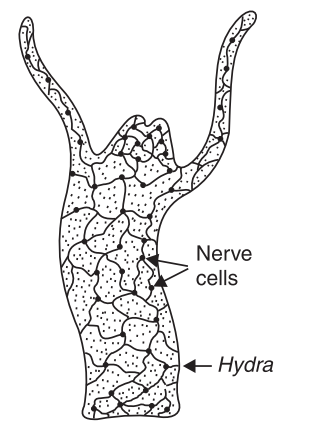 ears have sound receptors (which can detect sound), nose has smell receptors (which can detect smell), tongue has taste receptors (which can detect taste) whereas skin has receptors for detecting touch, pressure, heat (or cold) and pain, etc. The common type of receptors also have special names such as photoreceptors, phonoreceptors, olfactory receptors, gustatory receptors and thermoreceptors.
ears have sound receptors (which can detect sound), nose has smell receptors (which can detect smell), tongue has taste receptors (which can detect taste) whereas skin has receptors for detecting touch, pressure, heat (or cold) and pain, etc. The common type of receptors also have special names such as photoreceptors, phonoreceptors, olfactory receptors, gustatory receptors and thermoreceptors.
Photoreceptors detect light (they are present in eyes), phonoreceptors detect sound (they are present in inner ears), olfactory receptors detect smell (they are present in nose), gustatory receptors detect taste (they are present in tongue) whereas thermoreceptors detect heat or cold (they are present in skin).
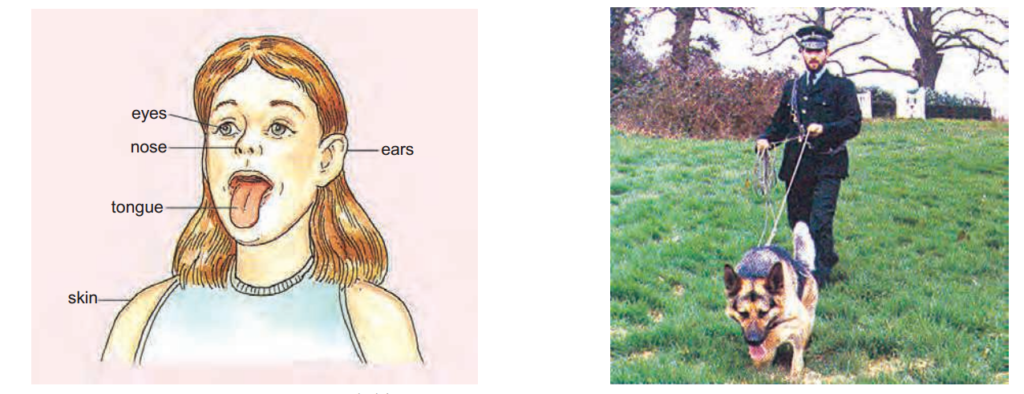
A stimulus is a kind of energy such as light, sound, smell, taste, heat, or mechanical pressure, etc. Receptors contain groups of cells which are sensitive to the energy provided by the stimulus. At a receptor, the energy provided by a stimulus sets off a chemical reaction which converts the energy of stimulus into an electrical signal called ‘electrical impulse’ (nerve impulse or just impulse).
So, all the receptors in the sense organs receive stimuli from the surrounding environment and send the message conveyed by them to the spinal cord and brain in the form of electrical impulses through the sensory nerves. Another type of nerves called motor nerves transmit the response from the brain and spinal cord to the ´effectors’, again in the form of electrical impulses. An effector is a part of the body which can respond to a stimulus according to the instructions sent from the nervous system (spinal cord and brain).
The effectors are mainly the muscles and glands of our body. All our muscles and glands respond to electrical impulses sent from the nervous system through motor nerves.
KSEEB Class 10 SSLC Biology Chapter 2 Control and Coordination in Humans
There are two systems of coordination of activities in humans. These are :
- Nervous system, and
- Endocrine system (or Hormonal system).
In human beings, nervous system and endocrine system work together to control and coordinate all our activities such as our physical actions, our thinking processes and our emotional behaviour. Both the systems of coordination, nervous system and endocrine system, consist of a number of organs working together in a systematic way. We will now describe the nervous system and endocrine system in humans in detail, one by one. Let us discuss the nervous system first.
KSEEB Class 10 SSLC Biology Chapter 2 Control and Coordination Human Nervous System
The function of nervous system is to coordinate the activities of our body. It is the control system for all our actions, thinking and behaviour. The nervous system helps all other systems of our body to work together. The nervous system is like a manager inside our body. Its job is to control and coordinate the parts of our body so that they work together, doing their job at the right time. Our nervous system coordinates muscles so that we can do things which need thinking like reading, writing, cycling or dancing.
“Control and Coordination Class 10 SSLC exam preparation”
The nervous system also coordinates things which we don’t have to think about, like heart beat and breathing. The human nervous system receives information from the surroundings, processes it, interprets it and then responds accordingly. The nervous system also passes information from one internal system to another. For example, as soon as we put food in our mouth, it immediately causes the release of saliva from the salivary glands.
The Unit of Nervous System : Neuron
The units which make up the nervous system are called nerve cells or neurons. So, neuron is the structural and functional unit of the nervous system. We can now say that nervous system is made of special cells called neurons. Neuron is the largest cell in the body (which looks like an electric wire).
Neurons contain the same basic parts as any other animal cell but their structure is specially adapted to be able to carry messages over large distances in the body quickly. The neurons carry messages in the form of electrical signals called electrical impulses or nerve impulses.
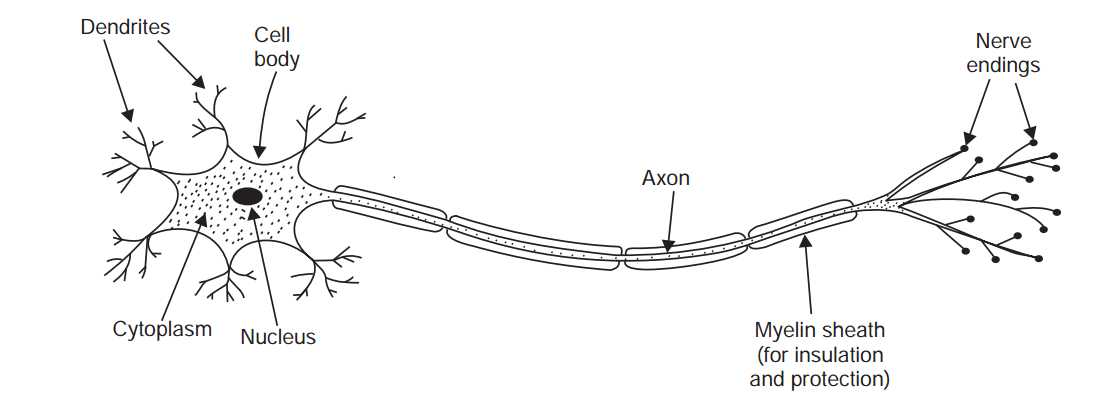
A neuron (or nerve cell) has three components :
- Cell body,
- Dendrites, and
- Axon.
The cell body of a neuron is like a typical animal cell which contains cytoplasm and a nucleus . A number of long and thin fibres are stretching out from the cell body of a neuron. They are called nerve fibres. The shorter fibres on the body of a neuron are called dendrites. The longest fibre on the cell body of a neuron is called axon. The axon has an insulating and protective sheath (or cover) of myelin around it (Myelin is made of fat and protein). It is clear that both dendrites and axon arise from the cell body of a neuron.
The messages which the neurons transmit in the nervous system are in the form of electrical impulses called nerve impulses (or just impulses). The dendrites pick up the nerve impulses (or messages) from receptors. They pass the impulses to the cell body and then along the axon. The axon passes the impulse (or message) to another neuron through a junction called synapse. Neurons are of three types : sensory neurons, motor neurons and relay neurons.
- Sensory neurons transmit impulses from the sensory cells (or receptors) towards the central nervous system (spinal cord and brain).
- Motor neurons transmit impulses from the central nervous system (spinal cord and brain) towards the muscle cells (or effectors).
- Relay neurons occur in the central nervous system (brain and spinal cord) where they serve as links between other neurons.
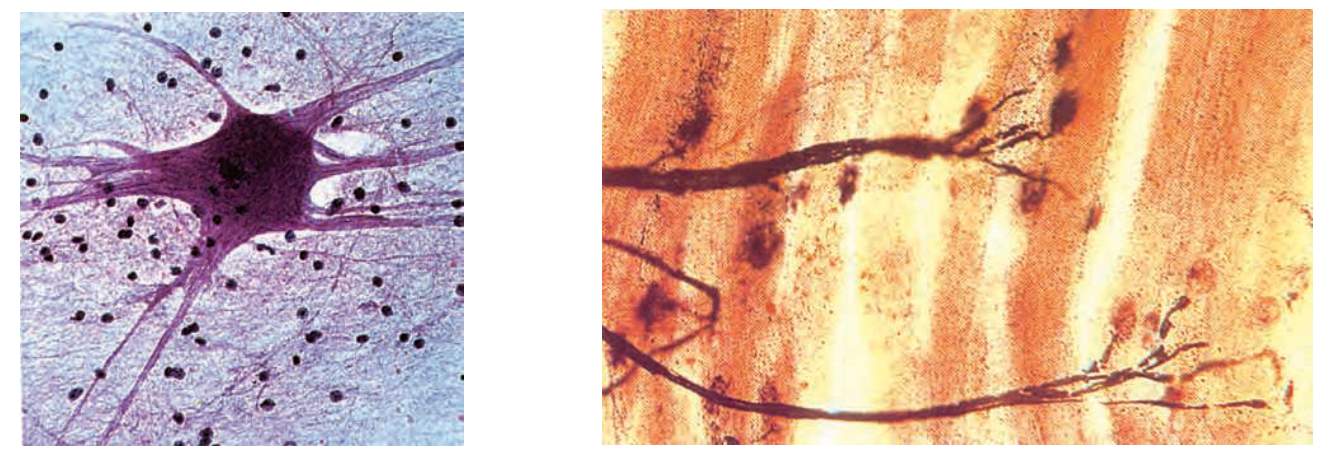
We will now explain how nerve impulses (or messages) are transferred from one neuron to another in the nervous system. Any two neurons in the nervous system do not join to one another completely. There is always a very, very small gap between the two neurons (where they join). This gap is called a synapse. The nerve impulses are carried over this small gap between a pair of neurons by means of a chemical substance called neurotransmitter substance.
We can now say that : A microscopic gap between a pair of adjacent neurons over which nerve impulses pass when going from one neuron to the next is called a synapse. Thus, synapses connect neurons (though it looks surprising that even gaps can connect two things !). We will now understand the conduction of electrical nerve impulses through synapse with the help of a diagram. Suppose there are two neurous (or nerve cells) A and B near each other .
Let A be a sensory neuron which is directly connected to the receptor. There is an extremely small, microscopic gap between the end of the axon of neuron A and the dendrite of the next neuron B which is called a synapse . We will now explain how the electrical impulse travels through the gap (synapse) between the two neurons. The receptor in a sense organ is in touch with the dendrites of sensory neuron. When a stimulus acts on the receptor, a chemical reaction is set off which produces an electrical impulse in it.
This impulse travels from the dendrite of sensory neuron A to its cell body and then along its axon. At the end of axon of sensory neuron A, the electrical impulse releases tiny amount of a chemical substance into the synapse (or gap). This chemical substance crosses the gap (or synapse) and starts a similar electrical impulse in the dendrite of the next neuron B. From the dendrite, this
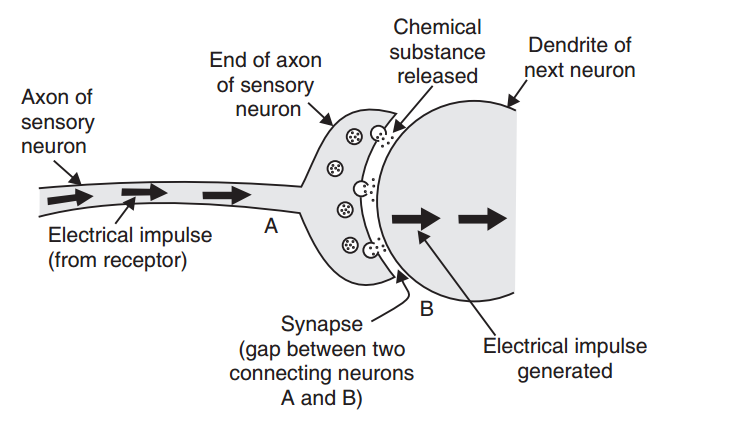 electrical impulse is carried to the cell body and then to the end of axon of the second neuron. It can then be transferred to a third neuron in a similar way. This process goes on till the electrical impulse reaches the relay neurons in spinal cord and brain. The relay neurons and motor neurons connect in a similar way to bring electrical impulses from the brain and spinal cord to the effectors like muscles and glands. Synapses actually act like one-way valves.
electrical impulse is carried to the cell body and then to the end of axon of the second neuron. It can then be transferred to a third neuron in a similar way. This process goes on till the electrical impulse reaches the relay neurons in spinal cord and brain. The relay neurons and motor neurons connect in a similar way to bring electrical impulses from the brain and spinal cord to the effectors like muscles and glands. Synapses actually act like one-way valves.
This is because the chemical substance is present on only one side of the gap. Due to this, the nerve impulses (or messages) through a particular set of neurons can go across only from one side (which contains the chemical substance). In this way, synapses ensure that
nerve impulses travel in only one direction (through a particular set of neurons).
KSEEB Class 10 SSLC Biology Chapter 2 Control and Coordination The Organs Of Human Nervous System
The main organs of the nervous system are: Brain, Spinal cord and Nerves. The sense organs like eyes, ears, tongue, nose and skin can be considered to be other organs of the nervous system because they help in the functioning of the nervous system. The main organs of the nervous system are shown in . The brain is located inside the skull of our head. The spinal cord is a very thick nerve which runs inside the cavity of backbone in our body.
The upper end of spinal cord is attached to the brain. The nerves are a kind of wires which are distributed all over our body. The brain and spinal cord are connected to all the sense organs and other parts of our body by millions of nerves. There are mainly two types of nerves in our body : cranial nerves and spinal nerves. The cranial nerves connect all the parts in the head directly to brain. The spinal nerves connect all the remaining parts of the body (like muscles and skin, etc.) to the spinal cord .
There is also a third type of nerves called visceral nerves. Most of the visceral nerves connect the internal organs of the body to spinal cord though some also connect to brain (Visceral nerves have not been shown in to keep the diagram simple and avoid confusion). The cranial nerves, spinal nerves and visceral nerves are also of two types : sensory nerves and motor

This is how the nervous system works : When the sense organ (like eyes, ears, tongue, nose, or skin) in our body is affected, it sends the message to the brain in the form of electrical impulses (called nerve impulses) through the sensory neurons. The brain analyses this message and decides the action to be taken. The brain then sends out instructions to the muscles of the concerned body part (for taking necessary action) through motor nerves. The concerned body part then acts according to the instructions sent by the brain.
Please note that in the processing of complicated responses (which require thinking) both, the brain and spinal cord are involved, but in the simple responses (which do not require thinking), the spinal cord alone is involved.
KSEEB Class 10 SSLC Biology Chapter 2 Control and Coordination The Parts of the Nervous System
The nervous system can be divided into two main parts :
1. Central nervous system (consisting of brain and spinal cord), and
2. Peripheral nervous system (consisting of all the nerves of the body like cranial nerves, spinal nerves and visceral nerves). The peripheral nervous system can be further divided into two parts:
- Voluntary nervous system (which is under voluntary control from the brain), and
- Autonomic nervous system (which operates automatically or involuntarily).
The classification of nervous system into various parts is given in the following chart:

KSEEB Class 10 SSLC Biology Chapter 2 Control and Coordination The Pheripheral Nervous System
All the nerves of the body together make up the peripheral nervous system (PNS). They all enter or leave the central nervous system. The three types of nerves which make up the peripheral nervous system are spinal nerves, cranial nerves and visceral nerves. Spinal nerves arise from the spinal cord along most of the length of the spinal cord and spread throughout the body (except the head). They all carry both sensory and motor neurons and are described as mixed nerves.
Cranial nerves arise from the brain and spread throughout the head. They also carry both sensory and motor neurons. The visceral nerves are a special kind of nerves which mostly arise from the spinal cord (though some also arise from the brain). They are connected to the internal organs of the body. Visceral nerves also carry both sensory and motor neurons.
KSEEB Class 10 SSLC Biology Chapter 2 Control And Coordination Reflex Action And Reflex Arcs
The simplest form of response in the nervous system is reflex action. This is a rapid, automatic response to a stimulus which is not under the voluntary control of the brain. It is described as an involuntary action. Thus, a reflex action is one which we perform automatically. It is a comparatively simple form of behaviour in which the same stimulus produces the same response every time. If we unknowingly touch a hot plate, we immediately move our hand away from it.
So, moving our hand away on touching a hot plate is an example of reflex action. Similarly, moving our foot away when we step on something sharp, is also an example of reflex action. A knee jerk, movement of diaphragm (during respiration), coughing, yawning, blinking of eyes and sneezing are all reflex actions. In a reflex action, we are unaware that anything is going to happen to us. Reflex actions are the actions which we do without thinking to protect ourselves.

For example, coughing is a reflex action which clears our windpipe. The pupils of our eyes get smaller in bright light. This reflex action protects the retina of our eyes from damage due to too much light.
“Karnataka SSLC Class 10 Biology Chapter 2 notes”
The pupils of our eyes get bigger in dim light so as to help us see properly even in dim light. The pathway (or route) taken by nerve impulses in a reflex action is called the reflex arc. Reflex arcs allow rapid response. We will explain the meaning of a reflex arc by taking an example. A reflex action is an automatic response to a stimulus. An example of the way in which we respond to a stimulus is our reaction to touching a hot object (like a hot plate). Very quickly, and without thinking about it, we pull our hand away.
This sort of very fast, automatic response is called the reflex action. Figure 30 shows the pathway taken by the nerve impulses in this reflex action. The stimulus here is the heat which we feel in our hand on touching the hot plate. This heat is sensed by a heat receptor (or thermoreceptor) in our hand. The receptor triggers an impulse in a sensory neuron, which transmits the message to the spinal cord. Here, the impulse is passed on to a relay neuron, which in turn, passes it to a motor neuron.
The motor neuron passes the impulse to a muscle in our arm. The muscle then contracts and pulls our hand away from the hot plate. The muscle of arm is an effector because it responds to the stimulus. This pathway along which the impulse travels is called the reflex arc.
 The reflexes of this type which involve only the spinal cord are called spinal reflexes. Though spinal reflexes are produced in the spinal cord but the message of reflex action taken also goes on to reach the brain. Please note that when we lift a hot plate, then alongwith heat, the pain produced by heat also acts as a ‘stimulus’. The reflex arc described in the above example can be shown in the form of a flow-chart given in .
The reflexes of this type which involve only the spinal cord are called spinal reflexes. Though spinal reflexes are produced in the spinal cord but the message of reflex action taken also goes on to reach the brain. Please note that when we lift a hot plate, then alongwith heat, the pain produced by heat also acts as a ‘stimulus’. The reflex arc described in the above example can be shown in the form of a flow-chart given in .
Most of the reflex actions involve only the spinal cord. They are called spinal reflexes. The reflex action which we have shown in is actually a spinal reflex. And the reflex arc given in is actually a spinal reflex arc. Some reflex actions, however, involve the brain rather than the spinal cord. Such reflex actions are known as cerebral reflexes. This is described below.
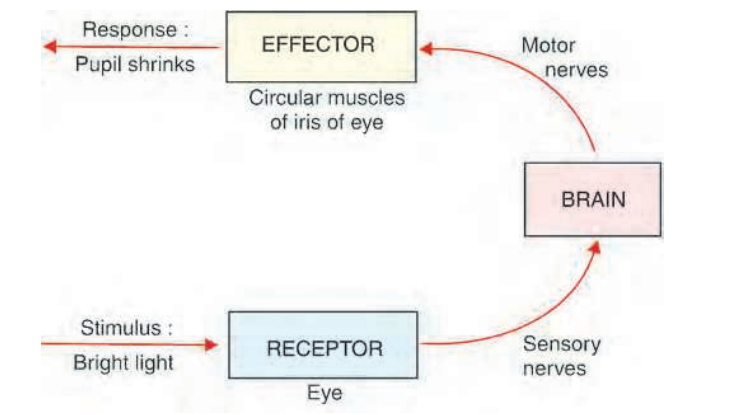 Those reflex actions which involve brain are called cerebral reflexes. Cerebral reflexes occur in the organs present in the head because these organs are directly connected to the brain. This will become clear from the following example. Our eyes are present in the head. In dim light, the pupil (a hole in the front of eye) is large so that more light can enter into the eye and make us see properly even in dim light .
Those reflex actions which involve brain are called cerebral reflexes. Cerebral reflexes occur in the organs present in the head because these organs are directly connected to the brain. This will become clear from the following example. Our eyes are present in the head. In dim light, the pupil (a hole in the front of eye) is large so that more light can enter into the eye and make us see properly even in dim light .
Now, when a bright light shines into our eye, then the pupil of our eye automatically becomes smaller (and prevents the damage to the retina of eye from too much light) . The contraction of pupil of our eye automatically in the presence of bright light is an example of cerebral reflex. This cerebral reflex action can be explained as follows: When a bright light falls on the eye, the light receptors in the eye produce impulses in the sensory nerves.
The sensory nerves carry this message of bright light in the form of electrical impulses to the brain. The brain produces the response (that the amount of light entering the eye must be reduced). The response produced by the brain is carried by motor nerves to the circular muscles of the iris of the eye. The circular muscles of the iris of the eye contract and reduce the size of the pupil (or hole) of the eye. As the size of pupil becomes smaller, the amount of light entering the eye is reduced. All this happens very, very quickly.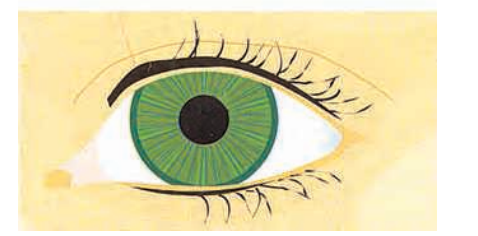

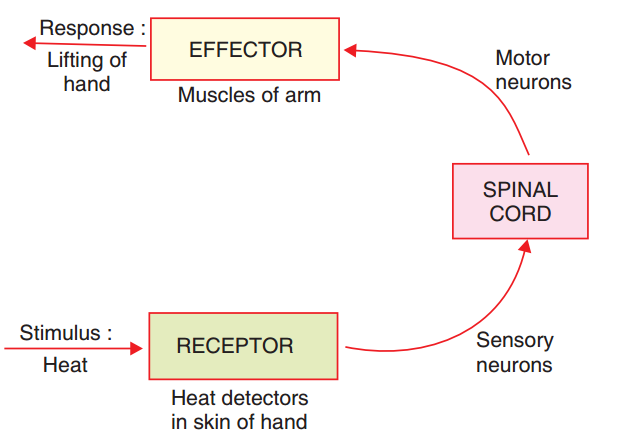
This cerebral reflex action can be shown by drawing a reflex arc given in Please note that though the pupil is a circular opening (or hole) in the centre of the iris of the eye but it appears to be dark because no light is reflected from it
How the Effectors (or Muscles) Cause Action or Movement
When a motor nerve impulse sent by the spinal cord (or brain) reaches the effector organs (which are muscles), then the muscles cause action or movement (such as lifting the hand away from a hot plate). We will now describe how muscles are able to move in response to electrical nerve impulses and cause action.
Muscles are made up of muscle cells. Muscle cells contain special proteins which can change their arrangement when stimulated by electrical impulses, causing the muscle cells to change shape and contract. When the muscle cells contract, the muscles also contract (and become shorter). When the muscles contract, they pull on the bones of the body part and make it move.
For example, when electrical impulses sent by the spinal cord (or brain) stimulate the biceps muscle of the upper arm, they make biceps muscle to contract. And when the biceps muscle contracts, it pulls on a bone of the lower arm and makes it move (lifting the hand away from the hot plate). Please note that the contraction of muscles (or muscle cells) caused by the action of electrical impulses is a reversible process.
KSEEB Class 10 SSLC Biology Chapter 2 Control and Coordination The Autonomic Nervous System
The term ‘autos’ means ‘self’ and ‘nomos’ means ‘governing’, so ‘autonomic nervous system’ means ‘self governing nervous system’. The autonomic nervous system is that part of the peripheral nervous system which controls the activities of the organs inside our body automatically even without our thinking about them. The autonomic nervous system is a specific network of nerves in the body which controls the processes like breathing, heart beat, digestion, sweating, etc.,
“Comprehensive Control and Coordination notes for SSLC”
that maintain our life and keep us alive. The nerves of the autonomic nervous system are attached to the smooth muscles of the various internal organs of the human body like head, heart, blood vessels, alimentary canal, lungs, kidneys, urinary bladder, glands and skin, etc. Thus, the autonomic nervous system controls and regulates the functions of the internal organs of our body involuntarily (on its own).
KSEEB Class 10 SSLC Biology Chapter 2 Control and Coordination Voluntary Nervous System
Those actions which need thinking and which are performed by us knowingly are called voluntary actions. For example, speaking to a friend, writing a letter, dancing, cycling, kicking a football, standing in a room or sitting on a chair, are all voluntary actions.

The voluntary nervous system helps us take voluntary actions which are under the conscious control of the brain. We will now give an example to understand the working of voluntary nervous system.
Suppose we are walking down to school at a slow pace. After covering some distance, we look at our watch and find that we are getting late. So, we start walking very fast. We can do this because of our voluntary nervous system as follows:
- When our eyes see time on the watch, they send this information to the brain through the sensory nerves.
- The brain analyses this information and decides that since there is risk of being late to school, so we should walk faster.
- The brain sends the instructions to walk faster to the muscles of our legs through the motor nerves.
The muscles of the legs act accordingly and make us walk faster.
This is an example of voluntary action and the decision to take this voluntary action has been made by the voluntary nervous system.
KSEEB Class 10 SSLC Biology Chapter 2 Control and Coordination Central Nervouse System
The central nervous system (CNS) consists of the brain and the spinal cord. Like a telephone exchange with ingoing and outgoing wires, it is responsible for the coordination and control of the activity of the nervous system.

The work of central nervous system is to direct incoming messages to the motor neurons that are connected to the part of the body which will respond to a stimulus. In complicated responses, the brain and spinal cord are both involved. That is, in complicated responses, central nervous system is involved. The central nervous system enables a person to give a more appropriate and more intelligent response to various situations.
By using the central nervous system, a person can vary his behaviour according to the changing situations. This point will become more clear from the following example. If we pick up a very hot plate in the kitchen (without knowing that it is very hot), then our reflex action produced by the spinal cord alone says that we should pull away our hand (so that our hand is saved from burns). But if we pull away our hand, then the plate would drop and break into pieces (and our mother will definitely scold us for breaking the plate!).
Now, it is here that the central nervous system involving brain steps in. When the message from our fingers saying that the ‘plate is too hot’ arrives at our central nervous system, there is already another message saying ‘but don’t drop it’ (This is due to the intelligence of the brain). The central nervous system will consider the two messages together. It may then decide to send a message to our muscles to tell them to put down the plate gently and not drop it.
This intelligent response has been made possible only due to the central nervous system. The job of the central nervous system is to collect all the information from all the receptors in our body. This information is added together before messages are sent out to the effectors. In this way, the best action can be taken in a particular set of circumstances. We will now describe the two organs of the central nervous system, brain and spinal cord in detail.
KSEEB Class 10 SSLC Biology Chapter 2 Control and Coordination Brain
Brain is the highest coordinating centre in the body. The brain is located inside the skull of our body (at the top of the spinal cord). It is protected by a bony box in the skull called cranium The brain is surrounded by three membranes called meninges, which help to protect it. The space between the membranes (or meninges) is filled with a cerebro spinal fluid which protects the brain from mechanical shocks. Pairs of cranial nerves arise from the brain.
The brain is broadly divided into three regions forebrain, midbrain and hindbrain. The forebrain consists mainly of cerebrum. The midbrain does not have any further divisions. The hindbrain consists of three centres called pons, cerebellum and medulla. We will now discuss the functions of the forebrain, midbrain and hindbrain. Let us start with cerebrum which is in the forebrain.
The cerebrum (or forebrain) is the main thinking part of the brain. It is the site of our faculties such as learning, reasoning, intelligence, personality and memory. All our thoughts, sensations, actions and movements are controlled by the cerebrum. The cerebrum has different areas for performing different functions. There are association areas in cerebrum which control thinking and
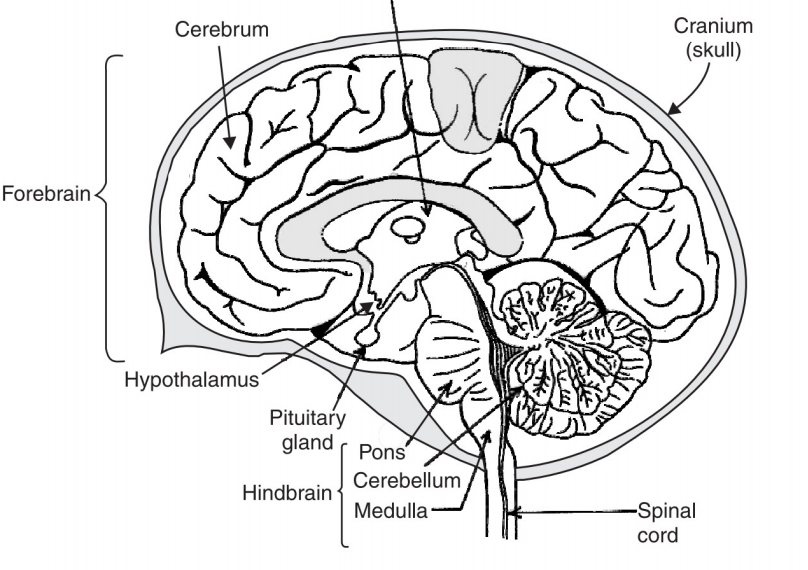
memory. These association areas also store information and experiences. There are sensory areas where information is received from the sense organs like eyes, ears, nose, tongue and skin, and give us the ‘sensation’ or ‘feeling’. Similarly, cerebrum has motor areas from which instructions are sent to muscles to do various types of jobs.
All the voluntary actions of the body are coordinated by the cerebrum. This happens as follows: The cerebrum receives sensory information through the receptors of sense organs. The cerebrum interprets this information in the light of previous experiences and takes a decision which it thinks is right. It then sends out instructions to the motor area (which controls the movement of voluntary muscles) so as to make voluntary muscles move to bring about the appropriate responses.
We will now describe the functions of midbrain. The midbrain controls reflex movements of the head, neck and trunk in response to visual and auditory stimuli. It also controls the reflex movements of the eye muscles, changes in pupil size and shape of the eye lens. We will now describe the functions of the parts of the hindbrain which are pons, cerebellum and medulla. The pons takes part in regulating respiration. The cerebellum helps in maintaining posture and balance of the body.
It also enables us to make precise and accurate movements. The cerebellum coordinates smooth body movements such as walking, dancing, riding a bicycle and picking up a pencil, etc. Medulla controls various involuntary actions such as heart beat (blood circulation), breathing, blood pressure and peristaltic movements of alimentary canal. Medulla is also the controlling centre for reflexes such as swallowing, coughing, sneezing, secretion of saliva and vomiting.

KSEEB Class 10 SSLC Biology Chapter 2 Control and Coordination Spinal Cord
Spinal cord is a cylindrical structure. The spinal cord begins in continuation with medulla and extends downwards. It is enclosed in a bony cage called vertebral column. Spinal cord is also surrounded by membranes called meninges. As many as 31 pairs of nerves arise from the spinal cord . The spinal cord is concerned with spinal reflex actions and the conduction of nerve impulses to and from the brain.
Before we end this discussion, we would like to give the various functions of brain. The various functions of brain are as follows:
- The brain receives information-carrying nerve impulses from all the sensory organs of the body.
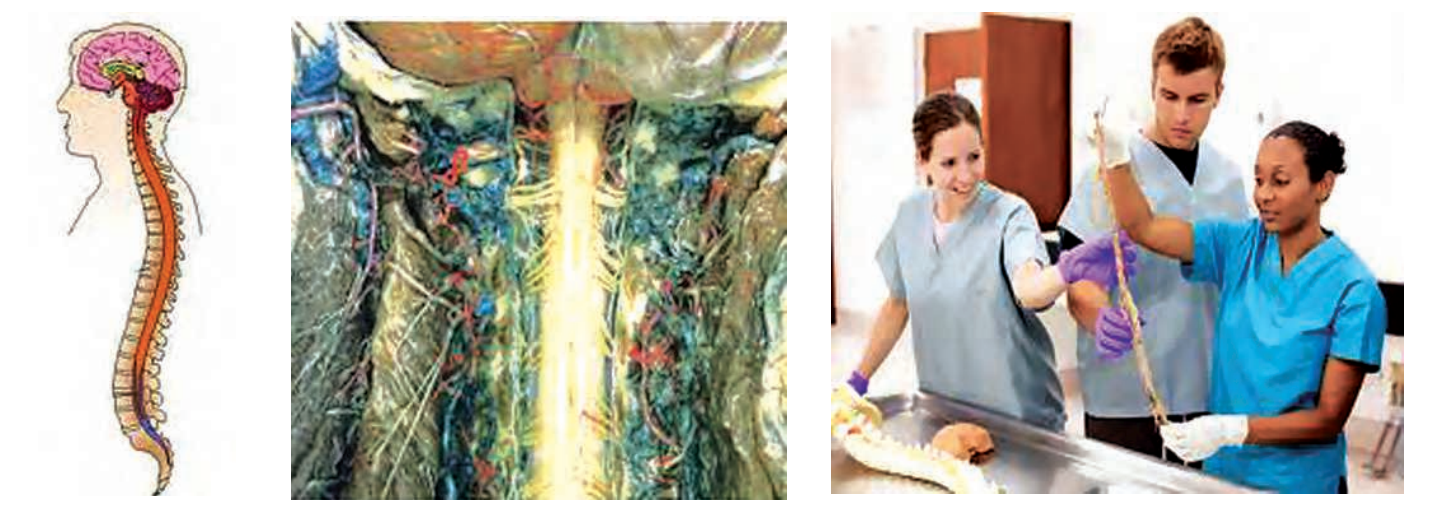
- The brain responds to the impulses brought in by sensory organs by sending its own instructions (through motor nerves) to the muscles and glands causing them to function accordingly.
- The brain correlates the various stimuli from different sense organs and produces the most appropriate and intelligent response.
- The brain coordinates the body activities so that the mechanisms and chemical reactions of the body work together efficiently.
- The brain stores ‘information’ so that behaviour can be modified according to the past experience. This function makes the brain the organ of thought and intelligence.
Before we describe the hormonal system or endocrine system for the coordination in human beings, we should know the meanings of two terms: hormones and endocrine glands. So, let us first discuss hormones and endocrine glands.
KSEEB Class 10 SSLC Biology Chapter 2 Control and Coordination Hormones
Hormones are chemical substances secreted in very small amounts by specialised tissues in the body called endocrine glands. These hormones coordinate the activities of living organisms and also their growth. So, we can now say that: Hormones are the chemical substances which coordinate the activities of living organisms and also their growth. Hormones are made inside the body of an organism in very small amounts. The various characteristics of hormones are given below :
- The hormones are secreted in small amounts by the endocrine glands.
- The hormones are poured directly into the blood and carried throughout the body by blood circulatory system.
- The hormones have their effect at the sites different from the sites where they are made. So, they are also called chemical messengers.
- The hormones act on specific tissues or organs (called target organs).
The hormones coordinate the activities of the body and also its growth.
KSEEB Class 10 SSLC Biology Chapter 2 Control and Coordination Endocrine Glands
A gland is a structure which secretes a specific substance (or substances) in the body. A gland is made up of a group of cells or tissue. There are two types of glands in the body :
- Exocrine glands, and
- Endocrine glands.
A gland which secretes its product into a duct (or tube) is called an exocrine gland. For example, the salivary gland secretes the saliva into a duct called salivary duct, therefore, salivary gland is an exocrine gland. Thus, exocrine glands are the glands having ducts ). A gland which does not have a duct and secretes its product directly into the blood stream is called an endocrine gland. Thus, endocrine glands are ductless glands. An endocrine gland secretes a chemical substance called hormone.
We can now say that : A structure (group of cells or tissue) which makes hormones in the body is called an endocrine gland. The various endocrine glands present in the human body are shown in The endocrine glands do not have ducts to secrete their hormones, so they are also called ductless glands. The endocrine glands release hormones directly into the blood of a person. These hormones reach the concerned body part through the blood and act on it.
“SSLC Class 10 Control and Coordination chapter key points”
Hormones are a kind of chemical messengers. A hormone is produced in one part of the body but it acts on some other part of the body. The hormones are of different types and perform different functions.
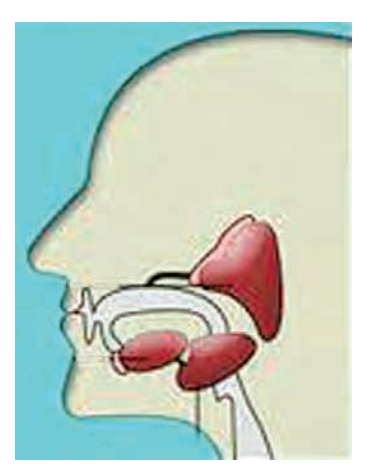
Some of the glands in our body have both exocrine and endocrine functions. The pancreas, testes and ovary are such glands. For example, pancreas acts as an endocrine gland and secretes the hormone insulin. It also acts as an exocrine gland and secretes pancreatic juice containing digestive enzymes into the pancreatic duct that leads to the alimentary canal. The testes are glands which act as endocrine glands and secrete the hormone called testosterone.
They act as exocrine glands and release sperms (male sex cells) into the duct. Similarly, ovaries are glands which act as endocrine glands and secrete the hormones oestrogen (read as ‘estrogen’) and progesterone. They act as exocrine glands and release ova or eggs (female sex cells) into the duct.
KSEEB Class 10 SSLC Biology Chapter 2 Control and Coordination The Endocrine System
A group of endocrine glands which produces various hormones is called an endocrine system. The endocrine system is also called hormonal system. We will now discuss the endocrine system in humans in detail.
In addition to nervous system, the endocrine system also helps in coordinating the activities of our body. The endocrine system in our body consists of a number of glands (or tissues) which make, store, and release chemicals called hormones.
There are a large number of endocrine glands in the human body. The endocrine glands present in the human body are: Pineal gland; Hypothalamus gland; Pituitary gland ; Thyroid gland; Parathyroid glands; Thymus ; Pancreas ; Adrenal glands ; Testes (only in males) and Ovaries (only in females). The positions of all these endocrine glands in the human body are shown in . The endocrine glands are located in different parts of the body. As we can see from , the endocrine glands are located in the head, neck and trunk of our body.
Different endocrine glands make different types of hormones which act on different organs of our body. The working of endocrine glands is controlled by our nervous system. The hormones produced by endocrine glands act as messengers between the nervous system and the organs of our body. We will now take the example of adrenal glands to show how the endocrine system (or hormonal system) coordinates our body activities.
There are two adrenal glands in our body, one on top of each kidney . The adrenal glands make adrenaline hormone. The adrenaline hormone prepares our body to function at maximum efficiency during emergency situations like danger, anger, excitement, etc.
This happens as follows: When we are faced with a dangerous situation (like being chased by a ferocious dog), then our nervous system stimulates the adrenal glands to secrete more adrenaline hormone into our blood. This adrenaline hormone increases our ‘heart beats’, ‘breathing rate’, ‘blood flow into muscles’ and causes liver ‘to put more stored glucose into our blood’.
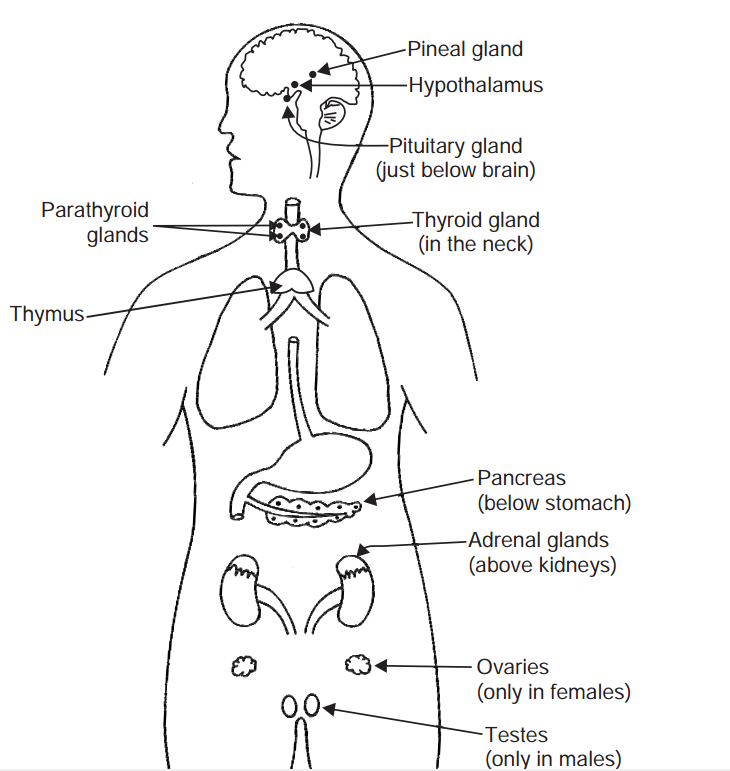
All these actions of adrenaline hormone produce a lot of energy in our body very, very quickly. And this energy helps us to run away very fast from the dog to save ourselves. In this way, the adrenaline hormone prepares our body to run away very fast from a frightening object. Similarly, it is the adrenaline hormone which prepares our body to fight an enemy (say, a burglar in our house) by providing us a lot of energy in a very short time.
A lot of adrenaline hormone is also secreted by adrenal glands when we are ‘angry’ or ‘excited’. The rapid output of energy thus caused helps us to cope with these extreme emotional situations.
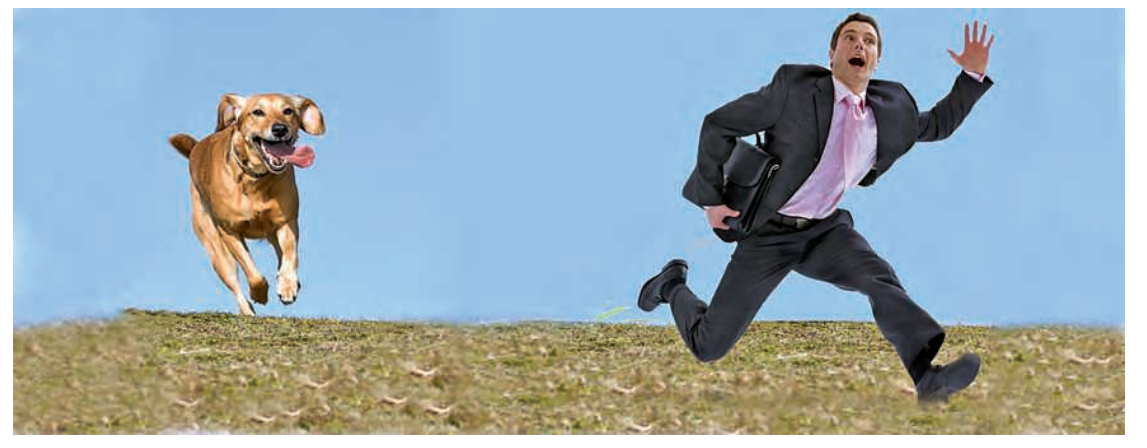
The complete coordination in the human body is achieved by the nervous system and endocrine system working together. The main centres in the body for the coordination of the two systems of control (nervous system and the endocrine system) are the hypothalamus and pituitary gland. The hypothalamus plays an important role in collecting information from other regions of the brain and from blood vessels passing through it.
This information is passed on to pituitary gland which by its own secretions, directly or indirectly, regulates the activities of all other endocrine glands. The hormones are involved in the regulation of several functions in the human body like growth, metabolic activities and reproduction. We will now give the names of the endocrine glands, the hormones released by these glands, and the functions of these hormones in the human body.
Please note that pineal gland which is present in the brain has no known function. Pineal gland is supposed to be a vestigial organ (Vestigial organs are those organs which no longer function). Let us discuss the other endocrine glands now.
1. Hypothalamus
Hypothalamus gland is present in the brain. Hypothalamus produces ‘releasing hormones’ and ‘inhibitory hormones’. The function of hypothalamus is to regulate the secretions of hormones from pituitary gland. That is, hypothalamus controls the pituitary hormones.
2. Pituitary Gland
Pituitary gland is present just below the brain. The pituitary gland secretes a number of hormones. One of the hormones secreted by pituitary gland is growth hormone (or human growth hormone). The growth hormone controls the growth of the human body. For example, growth hormone controls the development of bones and muscles. A person having a deficiency of growth hormone in childhood remains very short and becomes a dwarf. On the other hand, a person having too much growth hormone becomes verv tall (or a giant) .

3. Thyroid Gland
Thyroid gland is attached to the wind pipe in our body. Thyroid gland makes a hormone called thyroxine (which contains iodine). The function of thyroxine hormone is to control the rate of metabolism of carbohydrates, fats and proteins in the body. Iodine is necessary for the making of thyroxine hormone by thyroid gland, therefore, a deficiency of iodine in the diet can cause a deficiency of thyroxine hormone in the body.
The deficiency of iodine in the diet of a person produces less thyroxine hormone and causes a disease known as goitre. The main symptom of goitre is that the neck of the person appears to be swollen (due to the enlargement of thyroid gland located in the neck). People are advised to use iodised salt for cooking food so as to prevent goitre disease. This can be explained as follows: Iodine is required by the thyroid gland to make thyroxine hormone.
Iodised salt contains appropriate amount of iodine compounds (such as potassium iodide). Iodised salt can provide all the iodine needed by thyroid gland to make sufficient thyroxine for our body . Since there will be no deficiency of thyroxine in the body, goitre cannot develop.
4. Parathyroid Glands
There are four small parathyroid glands which are embedded in the thyroid gland . Parathyroid glands secrete a hormone called parathormone. The function of parathormone hormone is to regulate calcium and phosphate levels in the blood.
“Class 10 SSLC Control and Coordination important questions”
5. Thymus Gland
Thymus gland lies in the lower part of the neck and upper part of chest. Thymus gland secretes thymus hormone which plays a role in the development of the immune system of the body. Thymus gland is large in young children but shrinks after puberty (or sexual maturity).
6. Pancreas
The pancreas is just below the stomach in the body. Pancreas secretes the hormone called insulin. The function of insulin hormone is to lower the blood sugar level (or blood glucose level). Deficiency of insulin hormone in the body causes a disease known as diabetes. Diabetes disease is characterised by large quantities of sugar in the blood (and even urine). The insulin hormone controls the metabolism of sugar.
If, due to some reason, pancreas does not produce and secrete sufficient amount of insulin into blood, then the sugar level in the blood rises. The high sugar level in the blood can cause many harmful effects to the body of a person. The person having high sugar level in blood (or diabetes) is called a diabetic. Diabetic

persons are advised by doctors to take less sugar in their diet. Common diabetes can be controlled by controlling diet, reducing weight, doing regular physical exercise and taking medicines. The persons having severe diabetes are treated by giving injections of insulin.
7. Adrenal Glands
There are two adrenal glands which are located on the top of two kidneys. The adrenal glands secrete adrenaline hormone. The function of adrenaline hormone is to regulate heart rate, breathing rate, blood pressure and carbohydrate metabolism. Adrenaline hormone is secreted in small amounts all the time but in large amounts when a person is frightened or excited. When adrenaline is secreted in large amounts it prepares our body for action.
It speeds up heart beat and breathing, raises blood pressure and allows more glucose (carbohydrate) to go into the blood to give us a lot of energy quickly to fight or flight (run away). Adrenal glands are often called ‘glands of emergency’.
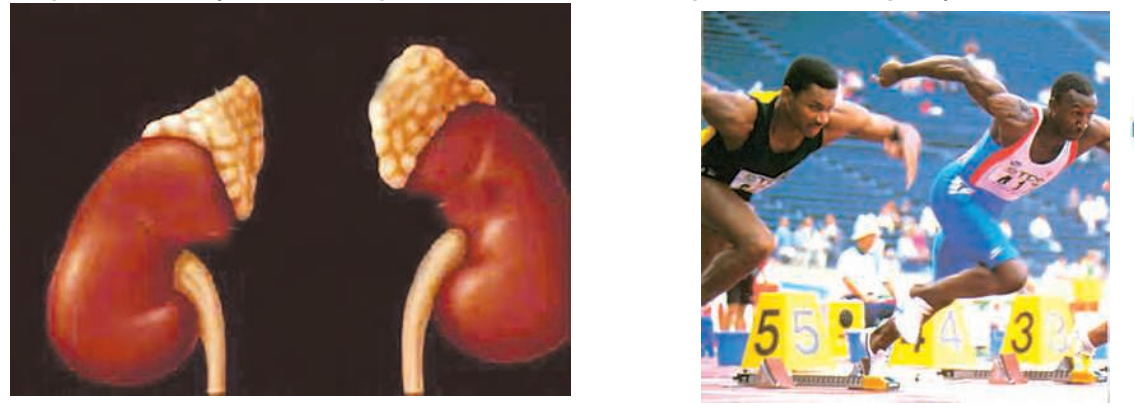
8. Testes
Testes are the glands which are present only in males (men). Testes make male sex hormones called testosterone. The function of testosterone hormone is to control the development of male sex organs and male features such as deeper voice, moustache, beard, and more body hair (than females). All these changes caused by testosterone are associated with male puberty which the boys attain at an age of 13 to 14 years. The testes also make the male gametes called sperms.
9. Ovaries
Ovaries are the glands which are present only in females (women). Ovaries make two female sex hormones called oestrogen and progesterone. The function of oestrogen hormone is to control the development of female sex organs, and female features such as feminine voice, soft skin and mammary glands (breasts).
All these changes caused by oestrogen are associated with female puberty which the girls attain at an age of 10 to 12 years. The function of progesterone hormone is to control the uterus changes in menstrual cycle. It also helps in the maintenance of pregnancy. The ovaries also make the female gametes called ova (or eggs).
KSEEB Class 10 SSLC Biology Chapter 2 Control and Coordination Feedback Mechanism
The excess or deficiency of hormones has a harmful effect on our body. For example, the deficiency of insulin hormone results in a disease called diabetes whereas excess of insulin in the body can lead to coma. So, it is necessary that the hormones are secreted by the glands in our body in precise quantities which are required for the normal functioning of the body. This means that there should be some ‘mechanism’ to regulate the production and release of hormones in the body.
“KSEEB Biology Chapter 2 Control and Coordination study material”
The timing and amount of hormones released by various glands are controlled by the ‘feedback mechanism’ which is in-built in our body. For example, if the sugar level in the blood rises too much, they are detected by the cells of pancreas which respond by producing and secreting more insulin into blood. And as the blood sugar falls to a certain level, the secretion of insulin is reduced automatically.
Before we end this discussion we would like to give a comparison of the nervous system and endocrine system (or hormonal system) for the control and coordination in humans (and other higher animals).


